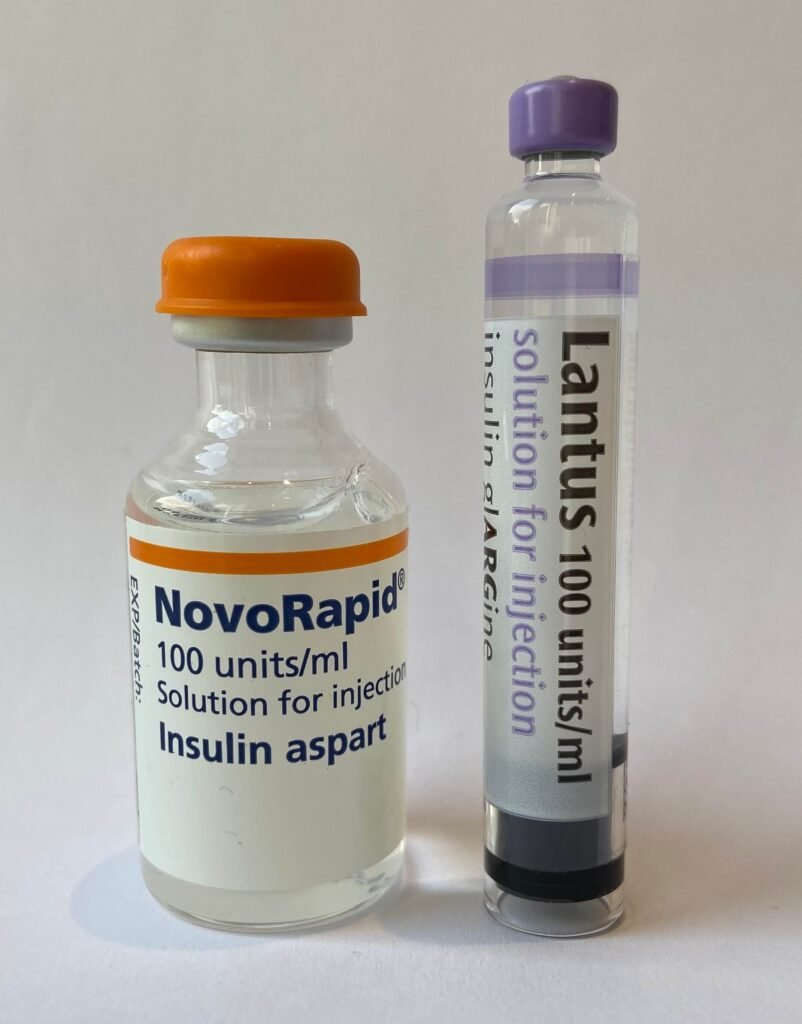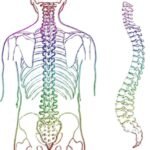Hormones, Neuropeptides and… Acid!
The content of the HealingT1D website is for educational and information purposes only. It does not contain medical advice. The contents of this website are not intended to substitute for professional medical advice, diagnosis or treatment. Please always consult with your doctor, physician, or other qualified healthcare professional before making any adjustments to your routine or healthcare regime. HealingT1D and all associated with it will not be held liable for any risks or issues associated with using or acting upon the information on this site.

Summary: This article discusses outlines the role of insulin in diabetes, highlighting how it is a hormone that acts on the permeability of cells. The discovery of insulin by Banting and Best is outlined, followed by a discussion of the modern-day insulins that are available. A consideration of the synthetic components contained within insulin are discussed, along with its properties of being both a hormone and a neuropeptide.
Ah, the elixir! The magic potent drug that keeps me alive and well. What would I do without you?!
Now, for me, it’s funny sitting here writing this post… For decades, I have (mostly!) diligently put insulin into my system. This has been via syringes (originally ones that were sterilised by boiling them in a saucepan!!) then insulin pen devices then an insulin pump and now syringes again. All those units of insulin, all those vials, all those bottles… But I actually know so little about this wonder drug! Is it even a drug?!
What Is Insulin?
So, to answer my first question… No, insulin is not a drug (until it is put into bottles and sold by pharmaceutical giants, anyway!). A plethora of books, articles and webpages kindly inform me that insulin is a hormone [1, 2, 3].
What Are Hormones?
Hormones are a type of molecule in the human body that are transported around the body by the circulatory system. They are taken to places in the body to stimulate specific cells or tissues to produce a predetermined action. The hormone insulin is produced in the pancreas in the beta cells. Insulin is then dispatched into the bloodstream to act on the glucose molecules found there. Insulin works by increasing the permeability of the cells in the human body. With increased permeability, each cell is able to absorb more glucose from the bloodstream, resulting in lower amounts of glucose molecules in the blood [4].
A Brief History Of Insulin
I have to admit that I’m not a great fan of learning about the past. I had a really boring history teacher when I was at school who, I think, successfully put me off history for the rest of my adult life. Saying that, I don’t mind a quick delve into the textbooks of the past when I feel there’s something to be gained. This is true for insulin.
Insulin was not discovered until 1922. Prior to its discovery, the life expectancy of children and young adults with type 1 diabetes was very poor, with deteriorating health and death always imminent. My mother’s great-grandmother was one of the early ones to suffer this fate, dying when she was just 19 years old.
Thankfully, advances have been made. In 1922, insulin was discovered by Frederick Banting and Charles Best, under the directorship of John Macleod, following their investigations into the pancreatic function of dogs [5]. They siphoned off a pancreatic extract from the dogs’ pancreases (what we now know to be insulin) and found that the dogs developed diabetes. By re-injecting this pancreatic extract back into the dogs, the dogs’ blood sugars were lowered.
The insulin that was extracted from the dogs’ pancreases in these experiments was not purified. Therefore, when it was injected for the first time into a human being, that of a fourteen year old boy, the lack of purification resulted in a sterile abscess and little effect on the blood sugar levels [6]. Banting and Best, with the help of their biochemist colleague J. B. Collip, purified the pancreatic extract, resulting in the first medically viable insulin [7]. In 1923, Banting and Macleod were awarded the Nobel Prize for their discovery of insulin.
Over the following decades, procedures for extracting insulin were refined. Eli Lilly began producing insulin from animal pancreases. He found that the insulin from dead pigs and cows was particularly suited to humans.
In 1982, ‘human’ insulin was produced for the first time. Human insulin is manufactured from genetically engineering the bacterium of yeast cells to produce insulin.
On the market today, there are over 40 different types of insulin available to the diabetic consumer. The vast majority of diabetics use human insulin. However, natural animal insulins, which have no synthetic properties, are still available in some countries, including my home country of the UK. I feel this fact is important to know when considering healing from Type 1 Diabetes. I wish to make my body as healthy as I can, which I believe involves removing as many extraneous toxins as possible.
Rapid-Acting, Short-Acting, Intermediate-Acting, Long-Acting…
Today, we are blessed to have so many different types of insulin available to us. Whatever our bodily responses to food, exercise and generally just staying alive(!), there is an insulin to match it.
i) Rapid-acting
ii) Short-acting
iii) Intermediate-acting
iv) Long-acting
v) Pre-mixed
Each of these types of insulin have different profiles for how long it takes them to start to work and how long they remain effective in the human body. Rapid-acting insulins, such as Novorapid (also known as Novolog), Humalog and Apidra, all start working in 10-20 minutes and last for two and half hours to five hours (although every human body is different so I only ever take these as rough guides until I’ve seen what they do to me in practice!).
Short-acting insulin tends to have a slower onset and duration than the rapid-acting insulins. Actrapid (also known as Regular insulin) is the most well-known type of insulin in this this group.
NPH is an intermediate-acting insulin, so-called because it takes 1-2 hours to start to work but then last in the system for about half a day.
In the long-acting group is insulin glargine (the most commonly known ones being Lantus and Toujeo), insulin determir (known as Levemir) and Insulin degludec (known as Tresiba). These have a much longer onset time, somewhere between one to two hours depending on the specific type, but last up to 24 hours or longer.
The last group are the pre-mixed insulins, which consist of both short-acting and long-acting insulins.Some examples are Humulin 70/30 and Novolog 70/30, both of which take 30 minutes to onset and last up to 24 hours.
The Lesser Known ‘Amylin’
As I was reading up on insulin production, I found that the insulin-producing beta cells in the pancreas don’t just produce insulin. They also produce another hormone… Amylin.
Amylin is the hormone that helps insulin to attain optimal blood glucose levels after meals. It has many roles…
1. It slows the digestive process, which means that carbohydrates take longer to enter the bloodstream. This results in smaller blood sugar spikes after meals.
2. Prevents glucagon being secreted from the pancreas. Glucagon is a hormone that is responsible for raising blood sugar levels. That means, for me as a type 1 diabetic, I have the added joy of MORE glucagon being released when I eat a meal. So my poor body has to cope with even more free-floating glucose in my bloodstream. Consequently, I have to take more insulin; some to cover the meal itself and some to cover this additional glucagon spike.
3. Amylin increases feelings of satiety. Increasing satiety would dissuade me from reaching for that third second piece of cake after dinner or that lovely chocolate cookie between meals. But, nope, I don’t have amylin. So THAT is why I feel like I… am… always… hungry!!
There is a product on the market called Symlin, which is synthetic amylin that can be used to counteract the lack of amylin in your system.
However, for me, that is not really a choice I wish to make. I am striving to get my body back to as natural a setting as possible and focusing on getting my body to regenerate itself as much as possible. But just knowing that there is a reason why I don’t ever feel satisfied at the end of a meal (no matter how full my belly is!) lets me know that that is okay. I can make peace with that.
My Experience of Insulin
I have been on a range of insulins over the years. When I was first diagnosed, I had two injections a day of mixed Actrapid and Monotard (an old long-acting insulin). This continued until I was eight or nine years old, when I was switched to Novorapid three times per day with meals and Protaphane at bedtime. I have played about with different types since then, including taking purely Novorapid through an insulin pump for a five-year period. Currently, my insulin regime tends to take one of two approaches:
When eating a carbohydrate-rich diet (50-100 grams per day), I find that Novorapid at meal times plus one large-ish dose of Lantus at bedtime is the most effective.
When eating lower amounts of carbohydrates (usually 30-40 grams per day), I require a different regime. I find that Actrapid is more effective for meals (since the protein content of my meals gives the larger blood sugar hit and this hits in later than simple carbohydrates) and two doses of Lantus (at night and in the morning) gives me better stability in my daily blood sugars.
Always Read The Label…
Now this was a bit of a shocker for me. I had always assumed that the insulin I was putting into my body on a more-than-daily basis was just that… Insulin. Well, it turns out that I have been duping myself. I decided to read the package leaflet for each insulin to discover what I was really putting into my body.
Lantus:
At the moment, I use Lantus (insulin glargine) from 3 mL pre-filled cartridges. These contain insulin glargine, plus the following inactive ingredients:
Novorapid:
I use Novorapid (Novolog) vials for my mealtime injections. They contain:
Insulin And The Brain
“You what?! What do you mean ‘insulin and the brain’? They have absolutely nothing to do with each other!” was my first thought on this topic. After all, I’ve never had discussions about my brain with my diabetologist. Well, it turns out that maybe I should…!
Early research believed that insulin purely existed in the pancreas and in the bloodstream. It was simply a hormone.
However, recent research is showing that insulin is in fact highly involved with the brain. It appears that insulin has several roles in the brain and is involved in multiple neural pathways [10].
Insulin was first found in the brain in the late 1970s by Jana Havrankova and colleagues [11]. This early research was conducted on rat brains but insulin has similarly been detected in human brains [12].
For this reason, researchers of today are now choosing to refer to insulin as a ‘neuropeptide’.
What Are Neuropeptides?
Peptides are protein-like molecules that are used by nerve cells (called neurons) to communicate with each other. They are made up of a string of amino acids and are usually shorter in length than proteins.
Neuropeptides are a specific type of peptide that are released from neurons (in the brain and central nervous system) and act on neighbouring neurons.
A hotly debated area in the world of neuropeptides and insulin production is whether or not insulin is made in the brain [13].
Whilst there appears to be no clear conclusion on this matter as yet [10], the latest research is strongly indicating that there is in fact insulin being produced by the brain [14].
Is Insulin A Neuropeptide Or A Hormone?
It turns out that insulin is BOTH… A hormone and a neuropeptide (see my post here for more on this topic). Insulin is produced in the pancreas by beta cells (in non-diabetics) and travels through the bloodstream to act on glucose molecules. This makes it a peptide hormone. However, as discussed above, some preliminary studies are indicating that it is also produced in the brain and acts on neighbouring brain regions.This firmly places insulin in the neuropeptide camp too.
Why Does It Matter If Insulin Is A Neuropeptide Or A Hormone?
Neuropeptides are mainly brain-focused. Hormones are mainly body-focused. Insulin is both a hormone and a neuropeptide. It has actions in both the brain and the body. Type 1 Diabetes results from a lack of insulin. So has the insulin production been disrupted in the brain or the body or both?
For me, it seems obvious that Type 1 Diabetes cannot be just a disorder of the pancreas. It is not a purely physical disease with a purely physical origin. If it acts in both the brain and the body and is produced in both the brain and the body, then both the brain and the body must go wrong at the time of the onset of T1D. Going forwards, this further underlines for me how my healing from T1D needs to involve both my mind and my body. Both of them need to be healed, not either in isolation from the other.
Summary
- Insulin is a hormone that T1Ds require to regulate blood glucose control.
- Insulin today comes in two types: synthetic ‘human’ insulins and natural animal insulins.
- Human insulins contain, as well as insulin, multiple additional ingredients including zinc chloride, metacresol, glycerol, sodium hydroxide and hydrochloric acid.
- Insulin acts on both the pancreas and the brain. It is therefore both a hormone and a neuropeptide.
- T1D can therefore be understood as being associated to both the mind and the body.
References
- Holt, R. I. G., and Hanley, N. A. (2012). Essential Endocrinology and Diabetes. Chichester, UK and Hoboken, NJ: Wiley-Blackwell Publishers.
- Scheiner, G. (2011). Think Like A Pancreas: A Practical Guide to Managing Diabetes With Insulin (2nd ed.). Cambridge, MA: Da Capo Press.
- Neal, M. J. (2012). Medical Pharmacology at a Glance (7th ed.). West Sussex, UK: John Wiley and Sons.
- Stryer L (1995). Biochemistry (4th ed.). New York: W.H. Freeman and Company.
- Banting, F. G., Best, C. H., Collip, J. B., Campbell, W. R., and Fletcher, A. A. (1922). Pancreatic extracts in the treatment of diabetes mellitus. Preliminary Report. Canadian Medical Association Journal, 12, 141-146.
- Quianzon, C. C., and Cheikh, I. (2012). History of Insulin. Journal of Community Hospital Internal Medicine Perspectives, 2(2), 10.
- Bliss M. (1993). The History of Insulin. Diabetes Care, 16(3), S4-7.
- https://www.iddt.org/diabetic-commonsense/the-great-debate-natural-animal-or-artificial-human-insulin
- https://www.sciencedaily.com/releases/2015/10/151027074802.htm
- Gray, S. M., Meijer, R. I., Barrett, E. J. (2014). Insulin Regulates Brain Function, but How Does It Get There? Diabetes, 63(12): 3992-3997.
- Havrankova J., Schmechel, D., Roth, J., Brownstein, M. (1978). Identification of insulin in rat brain. Proc National Academy of Science U S A, 75(11), 5737–4110.
- Dorn, A., Bernstein, H. G., Rinne, A., Ziegler, M., Hahn, H. J., Ansorge, S. (1983). Insulin and glucagonlike peptides in the brain. Anatomical Record, 207(1), 69–77.
- Blázquez, E., Velázquez, E., Hurtado-Carneiro, V., and Ruiz-Albusac, J. M. (2014). Insulin in the Brain: Its Pathophysiological Implications for States Related with Central Insulin Resistance, Type 2 Diabetes and Alzheimer’s Disease. Frontiers in Endocrinology, 5, 161-182.
- Molnár, G., Faragó, N., Kocsis, A. K., et al. (2014). GABAergic neurogliaform cells represent local sources of insulin in the cerebral cortex. Journal of Neuroscience, 34, 1133–1137.


GET HEALINGT1D’S FUTURE ARTICLES IN YOUR INBOX!
Get the latest musings and findings straight to your email inbox.

Natalie is a blogger with Type 1 Diabetes. Natalie's special gifts are questioning the status quo and being a rebel. She is using these gifts to question medical 'knowledge' and find a true cure for Type 1 Diabetes.
Recent Comments:
- Sandra on Nutrition Update
- latestModapks on Daniel Darkes
- Natalie Leader on Daniel Darkes
- Senna on Daniel Darkes
- Sandra on High Blood Pressure






This Post Has 2 Comments
Very interesting information! I began to look at my dosage of insulin to maintain good control when I read that Diabetics don’t get heart disease, circulatory issues and diabetic neuropathy because of poorly controlled sugars. They were actually side effects caused by excess of insulin. I am now using the Keto Diet to reduce insulin intake, lower LDL levels and offload a few kilos. I am very interested in homeopathy. Mainly to deal with the autoimmune side where regrowth of pancreatic beta cells can still be attacked and destroyed in this manner. I have had several occasions where, I wonder if something is beginning to work again, only to go down with a cold and back to square one again. Will keep posted how I progress. Last Hba1c was 6.9, Type 1 since 1984.
Hi Jenny,
Thank you so much for taking your time out to respond to this post. I am fascinated to hear about the research stating that high insulin doses are responsible for diabetes complications. I have always wondered why I’ve managed nearly 40 years of diabetes with no enduring complications. Fortunately, I am very sensitive to insulin so it looks like my small doses are the reason why! I hope the keto diet diet helps you with your health goals and I wish you well with it.
I also believe that ‘alternative’ therapies have a lot to offer diabetics and would love to hear more about your experiences of homeopathy. How have you found it helpful?
I also suspect, like you, that healing takes place periodically in my system and then resets after illness/high blood sugars/some other stressful event. At the moment, I am becoming hypoglycaemic more often (particularly overnight) and I have had to reduce my doses further. I have been doing a lot of meditation and wonder if it is having an impact. Time will tell!
I would love to hear how you get on with your healing. I set up this blog with the belief that, if we pool our knowledge and ideas together, the diabetic community can help each other to heal. The knowledge is within!